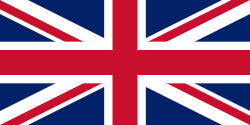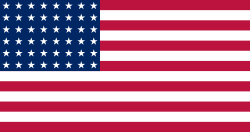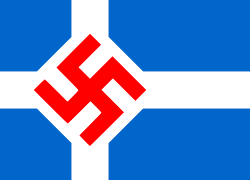| Flag | Date | Use | Description |
|---|
 | 1262–1397 | Flag of Norway | Banner of arms with golden lion on red canvas. |
 | 1397-1523 | The "Banner of the realms", flag of the Kalmar Union. | a red cross in a yellow field. |
 | 1523-1918 | Flag of Denmark | A red field charged with a white Nordic cross that extends to the edges; the vertical part of the cross is shifted to the hoist side. |
 | July 11th 1809-August 19th 1809 | Proposal for what the flag of Iceland might have looked like during the reign of King Jörundur | It’s not fully known what Jørgen’s flag really looked like. There are no surviving copies and his original description simply read as: “The Icelandic flag shall be blue, with three white stockfishes on it”. [1] Due to this vague description, there can be multiple different interpretations of what the flag looked like. The example shown here shows three stockfishes in the first quarter on a dark-blue field. The word “stockfishes” in Jørgen’s description could also be interpreted simply as “cods”, so the symbols on his flag might not have been stockfishes |
 | 1857-1869 | Standard of the Vestmannaeyjar Battalion (Herfylkingin) | A red saltire cross on a white field. In an old drawing of the Herfylking, the flag is shown with seemingly black text at the top and bottom of the flag, although it’s impossible to make out what the text says |
 | 1915–1944 [2] | National flag and civil ensign of Iceland | It is almost identical to the newer Icelandic flag but this has a lighter blue color. |
 | 1915–1944 [2] | War flag and Naval ensign of Iceland | It is almost identical to the newer Icelandic flag but this has a lighter blue color, just like the normal flag, above. |
 | 1921–1944 [3] | Royal Standard of the King of Iceland | Crowned Gyrfalcon on a blue field |
 | 1940-1944 | Flag of the United Kingdom, also commonly known as the Union Jack. | A superimposition of the flags of England and Scotland with the Saint Patrick's Saltire (representing Ireland). |
 | 1940–1944 | Flag of the United States | Thirteen horizontal stripes alternating red and white; in the canton, 48 white stars on blue field. |
 | 1941–1944 [4] | Standard of the Regent of Iceland | State flag of Iceland charged with a capital gold R on a rectangular panel |




















![]() Media related to Flags of Iceland at Wikimedia Commons
Media related to Flags of Iceland at Wikimedia Commons